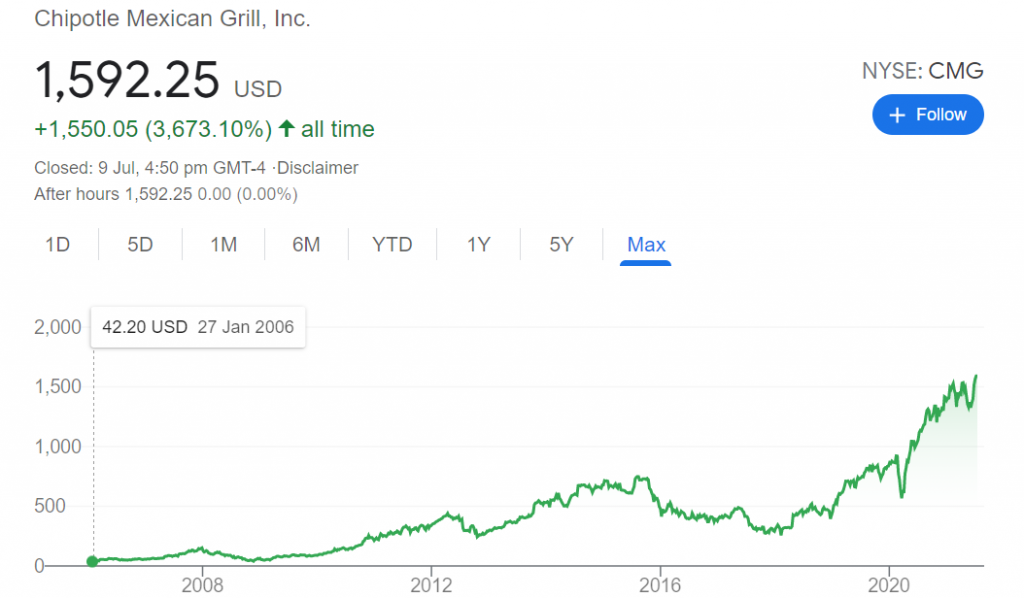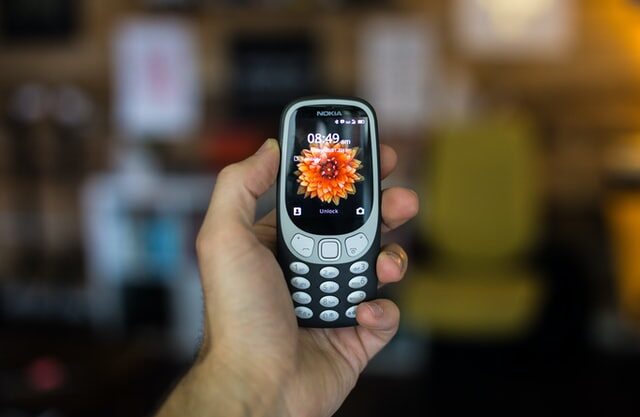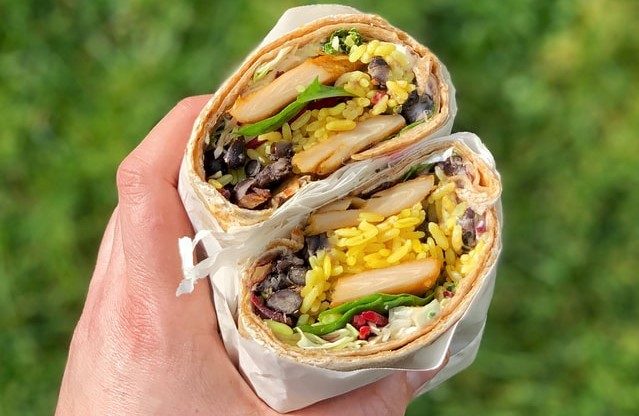With ~ $6 bn in revenues in 2020, presence in > 2,500 locations worldwide, and traded on the New York Stock Exchange as part of the S&P 500, Chipotle Mexican Grill has been the darling of investors.
Valued at more than $44.8 billion, just behind McDonald’s and Starbucks, Chipotle (pronounced as Chi-poht-lay) is a brand that seems to have got its story in place.
So what led a Mexican foodservice chain of Quick Service Restaurants (QSR) to such success, and its secret sauce? Let’s go through Chipotle’s journey, business model, and marketing strategy to reach here.
Setting up Chipotle’s business model
How It All Began
Chipotle was founded by Steve Ellis, who was doing his culinary studies in New York, where he saw the popularity of Mexican restaurants.
He took the idea and opened the first Chipotle outlet near the University of Denver, Colorado, back in 1993 by taking a loan from his father.
It didn’t take long for Chipotle to taste success, and in just four years, Chipotle’s 14 locations started ruling the Denver area generating revenues in the range of $14 to $18 million.
Chipotle’s success news reached the ears of the McDonald’s executives, and McDonald’s decided to support the brand by investing $50 million and then fund more as the brand grew.
This helped Chipotle scale up much faster than it had planned as it got McDonald’s monetary and executive support, their immense food knowledge as well as their playbook of running a large food chain.
Chipotle expanded further by opening a restaurant in Missouri in 1998 and then Minnesota in 1999. Continuing on this momentum, the brand grew massively to 460 restaurant locations by 2005.

Marriage Falling Apart
Chipotle and McDonald’s marriage lasted for a few years till chinks appeared in their relationship, and they decided to part ways. McDonald’s wanted Chipotle to follow a model similar to theirs by thinking of breakfast menu, drive-thrus, and even the idea of changing their name! By 2005, McDonald’s had a 90% stake in Chipotle.
In 2006, McDonald’s took back the $1.5 billion given to Chipotle thus far. Looking at the share price movement of Chipotle, if McDonald’s would have stayed with them a decade longer, that $1.5 billion would have become $15 billion. It was clear by the time the two parted ways that they had different approaches to business, food, philosophies, and strategies.
According to past McDonald’s CEO Steve Easterbrook, the company sold the shares in order to focus more of their energy and resources on their own “core brand,” as per magazine Entrepreneur.
Success of the Brand
Chipotle has done phenomenally well over the years, has stood its ground for the last 27 years, and is still growing strong. Let us look at some statistics:
- The brand gave its investors a return of more than 3,600% in the decade after its IPO.

- The net worth of Steve Ells grew to $200 million. Not bad for a person who launched Chipotle just as a backup plan to collect enough funds to start a fine dine restaurant. It was supposed to be a single restaurant but it become a global food chain!
- Unlike other brands scaling down, Chipotle has been increasing its outlets year after year.

Not a Smooth Sailing
Quality is one of the basic expectations from any food company, and a food poisoning scandal can turn off customers for good, eroding the brand equity quite quickly. This can send investors into panic mode, putting the restaurant’s future in jeopardy.
From 2015 onwards, Chipotle has faced multiple food poisoning scandals starting with a salmonella outbreak in one of its restaurants in Minnesota. Then, 35 new E. coli cases were reported in the restaurants of Washington and Oregon.
This was a PR nightmare, and Chipotle had to temporarily close 43 restaurants. Sales slumped by one-third, and the stock also took a beating in 2016 as a result of that.
The company took massive steps to put protocols in place, train all its employees, and ensure that best practices were followed across all its operations. It was all about enhancing Customer Experience.
Customer Experience: That is What Counts
Chipotle wants to deliver a consistently satisfying customer experience every time a customer crosses its outlets. They have put a few elements in place to ensure this:
1. 39-point checklist: Chipotle’s managers are evaluated on their performance quarterly and their adherence to a 39-point checklist. This checklist helps in avoiding mistakes and allows each restaurant to be run successfully.
2. Minimalist Design: Minimalism has been gaining ground since the past few years by many brands. For Chipotle, the minimalist design was more the need of the hour as it was done to save on costs. Today, Chipotle’s minimalist design of exposed pipes, lots of plywood and plethora of stainless steel is considered not only cool but also seen as part of brand philosophy of being authentic.
3. Curated Playlist: The company pays great attention to music that plays in its restaurants. They hired Chris Golub – an expert who creates special playlists for Chipotle by considering the food experience as well as the interiors of the restaurant to ensure that the music goes well in that atmosphere.
Marketing and Advertising Strategy of Chipotle
The success of Chipotle would not have been possible without its customer-centric marketing strategy:
1) Authenticity – This brand took all elements of a fast-food chain – quick service, big portions, low prices and yet carved its own identity by focusing on the use of fresh ingredients.
Incorporating the idea in its business model and marketing startegy, Chipotle has been building on the value of ‘Authenticity’ by telling stories about its ingredients and its employees across media touchpoints.
They ran an ad campaign, ‘For Real’, where they highlighted 51 ingredients that they use in their food:
2) Leveraging Digital: Since its consumers are largely Millennials and Gen-Z, Chipotle has used various digital platforms in quite a smart way:
- Snapchat: They introduced Snapchat stickers that the youngsters could use easily.
- Instagram: They launched a lid flip trick video of their employee on their Instagram page, which got 1 million views.
- TikTok: Chipotle was one of the first big brands to see the potential of the social video app. They took the lid flip challenge further with influencers on TikTok, getting a quarter-billion views in just a short time for the brand.
- Twitter: Since the official sponsor of NBA is Taco Bell, a direct competitor of Chipotle, they chose the route of guerilla marketing on Twitter to hijack the conversation around basketball during the NBA Finals. Every time an announcer said the word “free” on-air during game time, the food brand tweeted a special code that could be used to get a free burrito. The campaign did extremely well and gave Chipotle the reputation of an innovative marketer.
3) Personalized Marketing: Chipotle launched its loyalty club in 2019. In two years’ time, they got more than 23 million+ rewards members. With all the data at its fingertips, the burrito chain knows the food preferences of all its members.
Chipotle often surprises its members with special offers and also gets its consumers involved in the brand story. This kind of personalized marketing, using the power of data analytics, drives up engagement and footfalls for the brand, leading to more sales.
4) Staying Ahead of the Curve: Chipotle understood the power of mobile way back in 2008 and introduced an “order on mobile/pick-up in store” model almost a decade ahead of the competition. This eco-system turned out to be a boon for them in 2020 when people could not visit the restaurants so much.
5) Being purposeful: Gen Z consumers are conscious of the brands they engage with. So Chipotle launched ‘Real Foodprint’- a first-of-its-kind sustainability tracker that allows consumers to track how much water they helped save when ordering via their mobile app. In 2021, the brand even ran sustainability-focused ads on the Super Bowl – the most-watched sports event in the USA.
6) Getting closer to consumers: To drive brand visibility, Chipotle has been launching different merchandise over the years, which the brand loyalists love.
Beating the COVID19 Blues
Chipotle’s omnichannel marketing strategy has paid off handsomely.
With most restaurants and food chains being shut in 2020 due to the pandemic, you would also expect Chipotle to struggle to survive. Still, all the work that they did over the past few years in diversifying and building the digital eco-system paid off for them.
2020 was a blockbuster year for Chipotle’s digital sales, accounting for 46.2% of overall sales and growing by 174%. Chipotle’s revenue increased by 7.1% to $6.0 billion whereas comparable restaurant sales increased 1.8%
In first quarter of 2021, which was still the pandemic peak quarter, Chipotle’s revenue increased 23.4% to $1.7 billion whereas comparable restaurant sales increased 17.2% and their Digital sales grew 133.9% and accounted for 50.1% of sales.
It’s clear that Chipotle’s business model and strategy to make itself part of the culture, relevant and loved, embracing the digital mindset, and engaging with consumers across touchpoints has helped the brand thrive.
This brand has not even entered the markets of Asia and China and has still become such a huge brand. Imagine the potential that they can unlock in the next few years once they begin their geographical expansion!
-AMAZONPOLLY-ONLYWORDS-START-
Also, check out our most loved stories below

Why did Michelin, a tire company, decide to rate restaurants?
Is ‘Michelin Star’ by the same Michelin that sells tires, yes, it is! But Why? How a tire company evaluations became most coveted in the culinary industry?

Johnnie Walker – The legend that keeps walking!
Johnnie Walker is a 200 years old brand but it is still going strong with its marketing strategies and bold attitude to challenge the conventional norms.

Starbucks prices products on value not cost. Why?
In value-based pricing, products are price based on the perceived value instead of cost. Starbucks has mastered the art of value-based pricing. How?

Nike doesn’t sell shoes. It sells an idea!!
Nike has built one of the most powerful brands in the world through its benefit-based marketing strategy. What is this strategy and how Nike has used it?

Domino’s is not a pizza delivery company. What is it then?
How one step towards digital transformation completely changed the brand perception of Domino’s from a pizza delivery company to a technology company?

BlackRock, the story of the world’s largest shadow bank
BlackRock has $7.9 trillion worth of Asset Under Management, equal to 91 sovereign wealth funds managed. What made it unknown but a massive banker?

Why does Tesla’s Zero Dollar Budget Marketing Strategy work?
Touted as the most valuable car company in the world, Tesla firmly sticks to its zero-dollar marketing. Then what is Tesla’s marketing strategy?

The Nokia Saga – Rise, Fall, and Return
Nokia is a perfect case study of a business that once invincible but failed to maintain leadership as it did not innovate as fast as its competitors did!

Yahoo! The story of strategic mistakes
Yahoo’s story or case study is full of strategic mistakes. From wrong to missed acquisitions, wrong CEOs, the list is endless. No matter how great the product was!!

Apple – A Unique Take on Social Media Strategy
Apple’s social media strategy is extremely unusual. In this piece, we connect Apple’s unique and successful take on social media to its core values.
-AMAZONPOLLY-ONLYWORDS-END-

















